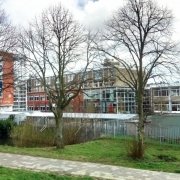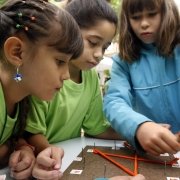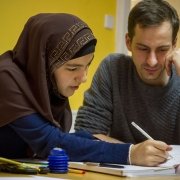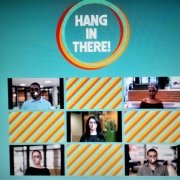Realizing the inclusive international, intercultural classroom. A professional learning community for higher education teachers.
Excerpt
In the academic year of 2015-2016, a group of twelve (effectively ten) university teachers of Rotterdam Business School formed a professional learning community, doing action research in their own practice and sharing knowledge about how to create a safe, inclusive learning environment in which every student experiences a sense of belonging. Each teacher came up with an intervention to improve his/her intercultural competency, applied it, analyzed it and wrote a research paper. The two project leaders researched and evaluated this working method and came up with recommendations for creating a working culture that encourages teachers to form a self-steering team of self-reflective practitioners, being a role model to their students. A second one followed the first round.
Narrative, origins and objectives of the initiative
What kind of project is this? Please give a short description (summary) of it.

In the academic year of 2015-2016, a group of twelve (effectively ten) university teachers of Rotterdam Business School formed a professional learning community, doing action research in their own practice and sharing knowledge about how to create a safe, inclusive learning environment in which every student experiences a sense of belonging. Each teacher came up with an intervention to improve his/her intercultural competency, applied it, analyzed it and wrote a research paper. The two project leaders researched and evaluated this working method and came up with recommendations for creating a working culture that encourages teachers to form a self-steering team of self-reflective practitioners, being a role model to their students. A second one followed the first round.
Please tell us why, in general, this project is considered a successful one?
The project was successful because it took place at the right moment, at the right time and with the right people. The moment was right because in 2014 five RUAS-colleagues (Rotterdam University of Applied Sciences), among which the project leaders, got inspired at a master class on Inclusive Excellence, organized by ECHO ("Dutch Expertise Center in Higher Education"). They learned a lot from this class. Back home, it had an influence on several other colleagues at RUAS. The time was also right because at RUAS, extra time and money were available for interventions, while diversity and inclusivity became hot topics during that time (2014-2015). The place and the people were right because one of the deans at RBS 'adopted' and supported the subject and central 'innovation money' could be spent on this project. The first round was filled with highly engaged teachers who were already sensitive to the subject. They could set an example to their colleagues.
And why would you consider it a grass-roots initiative?
The two project leaders wanted to start their initiative at the international business programs of RUAS (RBS) because of the diversity (international as well as intercultural, including domestic diversity) of the student population as well as the teaching staff in this institute, that are the highest within RUAS. They presumed that there were a lot of tacit knowledge about intercultural communication, and the challenge was to systematically discover and describe (some of) that knowledge. The plan to form a learning community of twelve teachers was, in other words, a way to facilitate and systemize already existent initiatives to cope with diversity and turn it into a strength.
What challenges needed to be solved in this project?
Being part of the highly diverse community of Rotterdam (and in general, of the four main cities of the western part of the country and their suburbs), Rotterdam University of Applied Science (RUAS) has a highly diverse (and rapidly changing) student population. Teaching staff, however, consists of merely middle-aged, middle-class white people. The universities in this part of the country have shown not to be able to keep up with all the changes over the last two decades. They (unintendedly) offer study programs for primarily white middle class, former high school, white (female) students. They are the traditional type of students who, as a result, outperform all other categories of students by far. Students of migrant backgrounds, of lower socioeconomic or income groups, international students, those who have secondary vocational educational backgrounds, males, disabled students, LGTB-students and probably many other students tend to study longer and/or show significantly higher drop-out rates. This is the so-called performance gap. This project and its ten teachers address this performance gap. Creating sense of belonging in a truly safe learning environment by an intercultural sensitive teacher is a fundamental first step to tighten this gap.
Is this initiative based on any particular theoretical framework? Which one?
Yes, it is based on Inclusive Excellence by Dr. Frank Tuitt cs. The work of, for example, Vincent Tinto, Caroll Dweck and John Hattie also inspired the participants. The aim was to “translate” this to the context of a Dutch international business school. To be more specific, this project is founded on three pillars ("the holy triangle"): Inclusive Excellence, Action Research and Collaborative Learning.
(Appendix) Is your intervention standing on its own or is it a part of a bigger and more holistic approach?
Within RBS, it was a stand-alone initiative, but within RUAS, there are more and sometimes aligned initiatives on all levels, addressing different target groups and recruiting / creating “ambassadors” throughout the organization. Moreover, one of the major aims of the project was to give general recommendations on how a (program) team should cooperate to move towards a quality-based, inclusive and self-reflective learning environment, and what this means in teams of management and facilitation (chapter 5 of the research report).
Please describe the group(s) intended as beneficiaries of this initiative
Why has this group (have these groups) been chosen?
RBS-teachers form a very diverse group within RUAS, dealing with a very diverse student population (internationally and intercultural, but of course in every other respect). Apart from helping teachers become more aware of their own prejudices and (sometimes unintentionally) acting upon them, the project leaders also presumed that, in this part of RUAS, there is a lot of prerequisite intercultural knowledge and skills waiting to be explored and described in a more systematic way.
Could you please tell us something about the relative size of the (of each) target group, within the school/university population, region and/or country?
This question is about the student population, I presume. RUAS-teachers were, however, the most prominent target group of this project. But eventually, of course, it is all about inclusive education on behalf of the students starting with their teaches being aware of their own backgrounds and their related world views, including (initially oblivious) prejudices, stereotypes etc. By doing this, teachers were supposed to improve their pedagogical and didactical skills, and increase their intercultural awareness and competency (see, for example the four dimensions of the Intercultural Readiness Check as described in the report).
Apart from a very diverse teacher population (especially the ones participating in the PLC: teachers of British, Japanese, Russian, Canadian, American, Chinese, Macedonian, Lithuanian, Estonian and (sometimes mixed) Dutch backgrounds), RBS houses students from all over the world, as well as students from the super diverse Rotterdam / Randstad area.
The biggest groups of students are formed by the Dutch (including students of Asian-Dutch, Moroccan-Dutch, Turkish-Dutch, Surinam-Dutch, Antilles-Dutch, etc. backgrounds), German, Mid-European, Chinese, Indonesian, Latin-American and Russian students. There wasn’t a single target group in this project, but several interventions related to Chinese students at IBMS, of which there were about 150 at the time (about 10% of the IBMS student population).
Which social characteristics are taken into account and what is the geographical area covered?
Most interventions of the teachers were about being more sensitive to their students and their needs, creating a safe learning environment in which all students experience a sense of belonging. Social characteristics of all different target groups / backgrounds are to be included as much as possible. To accomplish this each teacher should become fully aware of his/her own social characteristics (background) and, as a result of this, of his/her bias towards different kinds of students. The geographical area is, as mentioned earlier, the Rotterdam area.
On which level is the project implemented?
The primary focus of this project is on teachers and teams (professional learning communities exchanging knowledge), but from there, it also focuses on students, managers, deans and policy makers. The interventions are mostly about creating a safer learning environment, involving the students. Many interventions asked students for input. One of the major aims of the project leaders was to evaluate this way of working from an organizational point of view and the possibility to improve the working culture in program teams.
Please describe the political and socio-economic factors that you believe have been important enablers for your initiative
Did the initiative have political support?
Yes it did. One of the (then) deans of RBS funded a developed plan that (the project leaders came up with. At the start of the first PLC-round (in 2015) the initiators wrote a discussion paper that they discussed with RBS’s Deans and Management Team. The full team backed the paper and the plan, which made a good connection the existing strategic agendas of RUAS and RBS. From there, the project leaders started to recruit teachers and built the PLC.
How did it fit with local, regional or national policies?
The Dutch government (Ministry of Education, Culture and Science) encourages more diversity in HE, and stimulates the universities (especially in the big cities, the so-called Big Five) to address the performance gap (with stipendiums like the annual “Comeniusbeurs” to support innovative projects). In regional policies (e.g. Rotterdam The Hague metropolitan Area), there is even more sense of urgency because the urban population here is super diverse. The municipalities of Rotterdam and the Hague, for example, initiate several projects or participate in them to create a more inclusive local society and education. Apart from the so-called domestic diversity, the two main cities of the metropolis, The Hague and Rotterdam, have big international communities that must be included as well.
Who are the stakeholders supporting the initiative?
In this project, no real boundaries were set in relation to which minority groups were addressed. However, all participants received a training on Inclusive Excellence at the beginning of the project, addressing subjects like performance gap, stereotyping, white privilege, the Pygmalion effect etc. These subjects were discussed in the group. Each of the ten teachers who participated till the end of round 1 chose his or her own target group(s). In an international business school with highly diverse student and teacher populations, this appeared to be the best way to operate. Here are a few of the topics that were addressed:
- Features of students with severe study delays (their stories and perspectives);
- Differences in learning styles and expectations between students of different cultural backgrounds compared to teaching strategies of Dutch UAS-teachers;
- Culture shock in foreign students (and how it should be addressed);
- Collaboration and performance in multinational task groups;
- Expectations Asian teachers have of their students and the possible effects on non-Asian students.
Are there particular demographic changes present that are influencing the project?
Yes, the rapidly changing composition of urban populations in The Netherlands (especially Amsterdam, Rotterdam, and The Hague). Universities, at the moment, are not able to keep track of these changes and, therefore, unintentionally, reproduce inequality by offering a merely white middle class, ethnically Dutch teacher population and similar and corresponding curriculum to a highly diverse student population.
What is the institutional strategy and culture of the (educational) organization?
In August 2016, a new RUAS Strategic Agenda (https://rotterdamuas.com/globalassets/documenten/hogeschool/over-ons/our-agenda.pdf) and Educational Vision (https://hint.hr.nl/contentassets/69e15835803046739fadfed73d81bc71/vision-on-education.pdf) were introduced. The message is: RUAS wants to be at the heart of the (near) future developments in the region, helping a diverse student population to emancipate, obtain knowledge, skills and attitude they need to be part of the 21st century society. From then on, a number of central “workplaces” were formed around themes, trying to come up with a strategy and to convince a number of colleagues to do so too, by joining the working place of their preference. There is still a long way to go and, due to budgetary cuts, it is not easy to change the working culture in practice. A real challenge for the years to come!
To what extent does the initiative have an influence on institutional policy (or potential influence) of the (educational) organization?
One of the ambitions of the PLC-project was to show that it is possible to come up with and manage a working culture that encourages teachers to be truly self-reflective practitioners, enhancing their intercultural knowledge, skills and attitude, and, putting the aforementioned RUAS-Strategic Agenda and Educational vision in practice. The first round of the project concluded with a seminar about the PLC and its revenues. The CEO of RUAS and the dean of RBS were also invited and presented the first two copies of the research report. The second round, unfortunately, was not supported as well as the first one (especially financially) and, therefore, does not seem to be as promising as expected. Investments (in time and money) are needed if one genuinely wants to change the working culture. Still, a lot of knowledge is shared during the first and second round. There is a group of ambassadors within RBS, bringing in the topic wherever possible. Furthermore: aforementioned Workplaces. One of them is about inclusive didactic and pedagogy, containing elements of the PLC (like doing research, sharing knowledge and putting things into practice with a team of colleagues).
(Appendix) Is there public support for your initiative and the issue it addresses?
Yes, see above: the Ministry of Education and its advisory bodies like Onderwijsraad (“Education Council”), NGO’s like ECHO, local governments and organizations, municipalities of big cities, universities exchanging information and best practices on this topic, etc. all agree on promoting inclusion in education. Their ideals, however, are not easily put into effect. In reality, the segregation between ‘rich, privileged kids’ and ‘poor, underprivileged kids’ in the Netherlands, that already starts at primary schools, is big and continuously increasing. The aforementioned Onderwijsraad, for example, has been trying to alert the government (and society) about this for several years in a row now, but without the desired effect. Left wing and liberal political parties strive for more equality and emancipation in their programs, but they never form a majority and when a coalition is formed, many promises disperse in the joint government program.
(Appendix) What other factors do you think have been important for the success of this initiative?
Money and other means, allocated for innovation and to buy busy teachers time and 'headroom' to be able to reflect, cooperate and research (when their workload is too high, most teachers are not able to reflect).
The sensible design of the project, involving all layers of RBS (and RUAS), including the discussion paper and periodical updates of the progression of the project to the Management Team and deans during the first round.
The design of the project being open to more rounds and upscaling.
The extent to which the project fitted the existing agenda and ambitions of RBS, putting flesh on its bones.
Please describe the overall initiative design and the methods and tools used to reach the goals
Please describe the specific activities carried out.
In short (see also the project plan):
- Design and set the project up (the three pillar model, program of the first block etc.)
- Recruit candidate participants (there was room for twelve teachers; ten of them finished the first round. Each candidate completed a form and was interviewed as intake. The project leaders wanted to compose a varied research group in terms of gender, age, expertise, background, culture, nationality, research experience, etc.
- Organize and start the program. In the first block, the participants were trained in Inclusive Excellence, Action Research and Collaborative Learning. At the end of the block, every participant was expected to have (a blueprint / idea) of his / her intervention.
- In blocks 2-4, the group was self-supporting in structuring their meetings, sharing knowledge, forming sub groups, carrying out their interventions, evaluating and writing their research papers.
- After the academic year in which the PLC existed was finished, the members finished their research papers. The project leaders took exit interviews and started writing the report about the project. The first round of the project ended on 1 March 2017, and the seminar was held in August of the same year.
What were the key roles (teacher, student, management team etc.) within the project?
In this project the teacher and the learning community (that, in a way, was a model for a self-steering program team) played the key roles, but, as stated before, of course, the whole project was about providing the students with a genuinely inclusive learning environment.
What ideas, tools, theories, models, methodology (etc.) have been used to reach the goals?
Inclusive Excellence, Action Research, Collaborative Learning, the Harvard Implicit Bias Test, the Intercultural Readiness Check, analyses of surveys, held at the beginning, halfway through and at the end of the project.
Apart from that: all theories, methodologies etc. that the participants came up with formulating, executing, analyzing and evaluating their interventions.
What are the final revenues of the project?
Chapters 4 and 5 of the research report (“Findings and conclusions” and “Conclusion and recommendations”) answer the main question and the five sub-questions. In short:
- All participating teachers drastically improved both their intra- and interpersonal awareness.
- In the area of collaborative learning: participants progressed at building commitment, collaboration skills etc. However, in terms of ownership, organization and productivity, there is room for improvement.
- About using action research to come up with effective interventions: AR is proven to be a suitable method for teachers to reflect and experiment with didactical and pedagogical approaches to improve their practice. However, the aim that each participant come up with their own intervention, using AR, has only partly been met.
- About participants’ influence on attaining inclusiveness in their own environment: they do this in formal and informal ways and in different degrees (some being more influential than others; see examples on p.34). Formally, change agency was never a topic in this project.
- About “what recommendations can be made on how teachers can be facilitated to make education more inclusive?": this question is viewed from two perspectives: the PLC, next round (what can be improved, and in what way?) and actions that can be made by management and program teams (see 5.3, p.38).
Please describe if your project ensured its sustainability
If so, how did you ensure the short-term impact of the project?
See above: involving the deans, management, sharing knowledge with the rest of the RBS-community, conceptualize by reading relevant scientific literature, systematically research and monitor of the project, record and analyze all findings.
And how did you ensure the long-term impact of the project?
To construct a network of allies. During the two years of the first round of the project, however, many things changed at RBS, and these factors had a negative impact on the willingness to fund the project for more rounds.
Has your project been replicated elsewhere?
Elements of the PLC-project (stimulate bottom-up initiatives and knowledge sharing amongst peers, apply action research systematically) are used in other current projects at RUAS. The most important being a project called Werkplaats Inclusieve Pedagogiek en didactiek ("Workplace Inclusive Pedagogy and Didactics"; WIPD; this project is described elsewhere).
WIPD started in 2017 and shows some important similarities with the PLC-project. It is a good thing that elements and ideas of the PLC-project are used and tried in a different context. For example: the forming of learning communities of practitioners that exchange, discuss and share knowledge, stories and possible solutions; teachers formulating their own learning goals and transform them into interventions; the use of Action Research to evaluate the experiments as well as the project as a whole (the “two layer approach” that makes it possible to help practitioners to systemize, analyze, evaluate and improve their approach). The main differences are that the WIPD-project addresses RUAS as a whole (where the PLC project addressed only the RBS department) and that, by addressing the initiators as a ‘linking pin’, intercultural awareness may multiply faster and better spread throughout the organization. The PLC-project was initiated ‘from within’ RBS and its setup has been truly democratic (no supervision, only intervision), where WIPD is initiated by members of central staff: each plan has been criticized by a central panel end each experiment is monitored and researched by the WIPD ‘staff’ as well as supported and monitored by an advisor (member of the Expertise group). These are very interesting differences to compare during evaluation; each approach may have its virtues and risks.
The good thing is, to elaborate on the question, that at RUAS, a network of inclusivity ambassadors arose in recent years, sharing knowledge and make use of ‘lessons learned elsewhere’ when setting up a project. In that respect, it is to be expected that (elements of) WIPD will also be replicated elsewhere in the years to come.
Please tell us about the resources used in this initiative
What was the budget for the initiative?
In 2015, the project leaders came up with a plan for max. €200.000 (part of a large extra sum the Board released for innovative projects at RUAS). In practice, about €110.000 of this amount was used during the first round (main debit items being the research (development) hours of the teachers, the research hours of the project leaders, external experts hired to mentor the participants, support the project and contribute to the program of the first block).
How much did the initiative depend on volunteers?
To some extent. Some of the participants and other colleagues helped out editing each other’s research papers and the final research report. Student assistants helped transcribing interviews and one of them helped designing and styling the final report.
How were the costs perceived by the public/the sector/other stakeholders?
Most stakeholders who heard about the project indicated they appreciated the time and money spent on innovation and the achievement of knowledge and skills in this project. This also goes for the board, the deans, management team and the involved teachers, as well as partners and important friends like the people of ECHO and other persons in the network. Most of the other teachers and employees who heard about the project were interested. Not everybody, though, understood the goals and the fact that it didn’t deliver tailor-made solutions to complicated problems like the performance gap right away. Or that a project like this takes time and can’t reach everyone at once. The project leaders think that, to a certain extent, this is unavoidable and inherent to complicated issues like this. However, it must be emphasized that most reactions were positive.
To what extent did the initiative achieve its objectives?
Please describe the evidence to support the success of your initiative.
See chapter 4 of the report:
Results of the IRC, two trials (before participating and after)
Results of surveys and interviews, taken during different phases of the project
Results measured in some of the interventions
Did the intervention lead to any unintended (positive) outcomes?
Yes, participants engaged in several kinds of activities, e.g. in boards / committees; see some examples on p.34 of the report.
What indicators (quantitative and qualitative) have you measured to demonstrate success?
Same answer as first part of this question (chapter 4 of the report), namely:
Results of the IRC, two trials (before participating and after)
Results of surveys and interviews, taken during different phases of the project
Results measured in some of the interventions
(Appendix) How did you evaluate/monitor this intervention?
The project was evaluated and monitored in several ways: (Informal) talks, interviews, external experts (critical friends), surveys.
(See project description Q6 sub 1 and see the report.)



 Robinson Henao
Robinson Henao



